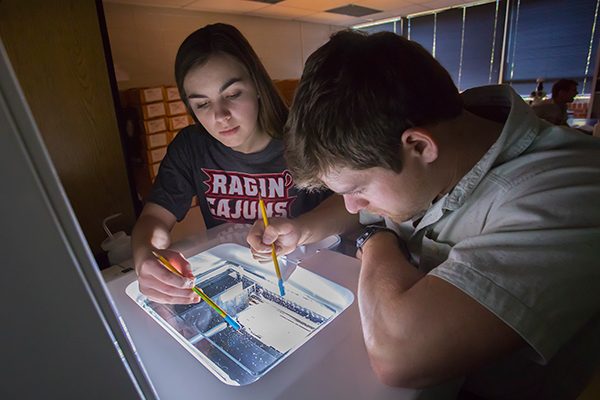Not all underwater treasures come in wooden chests. Just ask Dr. Kelly Robinson, an assistant professor of biology at the University of Louisiana at Lafayette.
Cardboard boxes abound in her Billeaud Hall lab. There are nearly 850, tucked beneath tables and desks and stacked two columns deep along walls.
The cartons aren’t Robinson’s deep-sea riches, but their contents are: about 11,640 one-liter plastic containers, holding seawater and untold numbers of microscopic plankton that dwell within it.
Robinson studies marine ecosystems, and regularly hunts the Gulf of Mexico in search of the wee sea creatures that play a big role at the base of the marine food chain. Plankton include newborn shrimp, crab, and oysters, among others.
But to secure this boxed and plastic-encased bounty, the biologist didn’t charter a boat. She rented a moving truck and ferried the specimens a thousand miles from the University of Miami to UL Lafayette.
Robinson joined the Department of Biology faculty in 2015. Shortly after, a former professor contacted her. Miami was shuttering its Fisheries Oceanography Lab, and a portion of its collection – 11,640 containers of seawater and preservative that once held larval fish – needed a new home.
The fish were gone, but Robinson’s prized plankton surely remained. Was she interested?
Her lab teems with the answer to that $4 million question. That’s the sum Robinson estimates she would have needed for multiple boat treks into the Gulf to amass the number of specimens she received – for free – in a single truck trip to and from Florida.
In Billeaud Hall, Robinson and undergraduate and graduate students work encircled by what the biologist refers to as her “rainy-day data fund.” Should research dollars run short, or proposals fall through, she has her cardboard boxes, and the treasures within, on which to rely.
The plankton have proven to be valuable teaching tools, as well. If Robinson needs examples for students to study using microscopes and a ZooScan – a scanner that captures digital images of specimens floating in a shallow chamber of water – the boxes yield that bounty, too.
How Robinson and her students organized and catalogued the specimens – and how they’ve harvested the power of technology and big data to examine and archive them and others – were the subjects of two articles in international science publications late last year.
Read them by clicking the links above.
Photo caption: Aidyn Creson, left, and Zach Topor examine plankton using a ZooScan, a scanner that captures digital images of specimens floating in a shallow chamber of water, in Dr. Kelly Robinson's lab. Creson is an undergraduate biology major. Topor is pursuing a Ph.D. in biology. (Photo credit: Doug Dugas / University of Louisiana at Lafayette)
